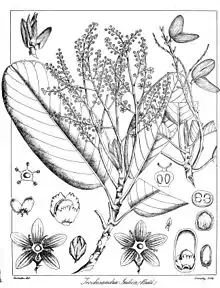Bhesa
Bhesa is a small genus of woody plants in the family Centroplacaceae. Its natural distribution is from southern China to New Guinea. It was formerly classified in Celastraceae, until a molecular phylogenetic study placed it in the family Centroplacaceae in the order Malpighiales.[1]
| Bhesa | |
|---|---|
 | |
| Bhesa indica | |
| Scientific classification | |
| Kingdom: | Plantae |
| Clade: | Tracheophytes |
| Clade: | Angiosperms |
| Clade: | Eudicots |
| Clade: | Rosids |
| Order: | Malpighiales |
| Family: | Centroplacaceae |
| Genus: | Bhesa Buch.-Ham. ex Arn. |
There are eight species:[2]
- Bhesa andamanica N.Balach. & Chakrab.
- Bhesa archboldiana (Merr. & L.M.Perry) Ding Hou
- Bhesa ceylanica (Arn. ex Thwaites) Ding Hou
- Bhesa indica (Bedd.) Ding Hou
- Bhesa nitidissima Kosterm.
- Bhesa paniculata Arn.
- Bhesa robusta (Roxb.) Ding Hou
- Bhesa sinica (H.T.Chang & Liang) H.T.Chang & Liang
References
- Kenneth J. Wurdack and Charles C. Davis (2009), "Malpighiales phylogenetics: Gaining ground on one of the most recalcitrant clades in the angiosperm tree of life", American Journal of Botany, 96 (8): 1551–1570, doi:10.3732/ajb.0800207, PMID 21628300
- "Bhesa Buch.-Ham. ex Arn. | Plants of the World Online | Kew Science". Plants of the World Online. Retrieved 2020-02-03.
This article is issued from Wikipedia. The text is licensed under Creative Commons - Attribution - Sharealike. Additional terms may apply for the media files.